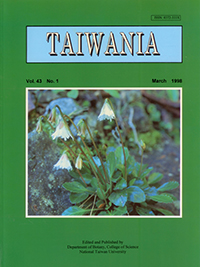Research Paper
Plant Communities along the Sewage Effluents Channels of Lyari River in Pakistan
M. Zafar Iqbal, Damian Gill and Muhammad Shafiq
Published on: March 1998
Page: 1 - 11
DOI: 10.6165/tai.1998.43(1).1
Abstract
The vegetation around the Lyari river was mostly dominated by monocotyledonous species viz Paspalidium geminatum, Cyperus laevigatus, Chloris barbata and Aeluropus lagopoides. Nineteen species were recorded on the heap area forming six plant communities, whereas, on the plain area seven species with five communities were observed. P. geminatum was the most dominant species on both areas, which indicated its tolerance to sewage pollutant. Edaphic characteristics of both areas (pH, CaCO3, organic matter, Na+, K+, Pb++, Zn++, Cu++) showed a significant correlation with the vegetation types. High soil pH, exchangeable sodium and potassium, zinc, copper with low calcium carbonate and organic matter were observed on the plain as compared to the heap area. However, a similar range of lead level was found on both areas. The availability of copper increased with the increase in soil pH on both areas. The availability of copper concentration was found above the toxic permissible limit of 150 ppm on both areas which ranged from 200 to 640 ppm. The concentration of zinc fell under the permissible toxic level and did not exceed 300 ppm.
中文摘要
里亞力河沿岸植被的優勢種多為單子葉植物,如 Paspalidium geminatum (類產稗)﹑Cyperus lavigatus (平滑莎草)﹑Chloris barbata (孟仁草) 及 Aeluropus lagopoides (獐茅)。在泥堆上計發現6種植物社會及19種植物,而在平坦地區有7種植物,形成5種植物社會。P. geminatum 在兩區均佔絕對優勢,凸顯出該種對污水的高容忍性。兩類地區的土壤特性 ( pH、CaCO3、有機質、Na+、K+、Pb++、Zn++ 及 Cu++ )均與植被類型呈相關。泥堆之土壤 pH、可交換性鈉、鉀、鋅及銅均高於平坦地,CaCO3及有機質則相反,但是鉛之含量則相同。銅之有效性在兩區均隨著土壤之pH增高而上升,同時其濃度為 200~640 ppm,均高於最低毒害濃度(150 ppm)。鋅之濃度則降低到有毒標準以下,而且未超過300 ppm。 關鍵字:重金屬、植物社會、河川、污水、排放、土壤特性。
Keyword: Heavy metals, Plant communities, River, Sewage, Effluents, Soil characteristics.


